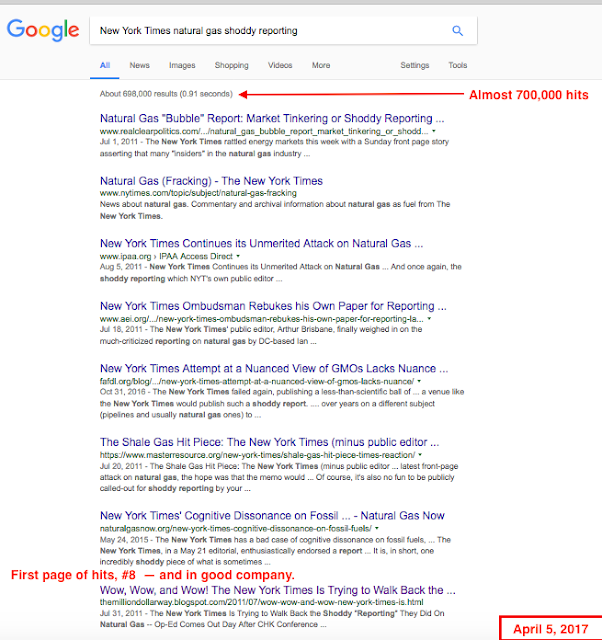Updates
Later, 11:42 a.m. Central Time: this story reminds me of the shoddy reporting The New Times did on the natural gas revolution some years ago. I see that with very biased googling ["New York Times natural gas" shoddy reporting] this blog is the #1 and the #2 hit. LOL. By removing the quotation marks, this blog still makes the first page of hits out of 698,000 "results." The really neat thing is the dating of the posts and the stories.
The NY Times, one might recall, was also incredibly negative about the expanded Panama Canal. With regard to the Panama Canal story, it appears The New York Times is trying hard to gild the lily (with little success, so far) -- the most recent update was July 31, 2016, and in the big scheme of things a pretty good example of a lot of writing with not much of a bottom line.
Later, 10:35 a.m. Central Time: a reader notes:
I have been following developments in the Appalachian Basin for some time now, and I must say that this past 6 to 8 months have shown absolutely astonishing results.
Not only is the output from Marcellus and Utica targeted wells stunningly productive, the expansion of the Utica through north central Pennsylvania and northward in Ohio continues apace.
Furthermore, the output from several dozens shallower Upper Devonian wells is approaching near-Marcellus like characteristics, i.e., highly productive.
There will be a century's worth of natgas emanating from that area.
Several big pipelines are only a few months away from completion and the boost in output should be remarkably large.
Original Post
Gas giants share OPEC's shale pain as US supply flows east -- Bloomberg.
OPEC isn’t the only decades-old energy hegemony being turned on its head by U.S. shale.
Liquefied natural gas sellers from Qatar to Malaysia that dominated gas sales to Asia for years are facing the prospect of rising American exports. While less than 30 U.S. cargoes have landed in Asia, their effect was felt even before they arrived. LNG trade in 2016 jumped the most in five years, contract lengths were sliced in half in the past decade, and spot prices slumped more than 60 percent in the past three years.
That means the global LNG titans gathering in Tokyo this week for Gastech are in the midst of the biggest shakeup since the industry was founded in the 1960s. Just as American crude is increasingly making its way to Asia, the world’s biggest oil market, the burgeoning armada of gas cargoes from the U.S. and elsewhere are poking holes in the financial system on which the industry’s multi-billion plants are funded.

No comments:
Post a Comment